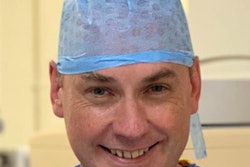
I've always thought of myself as stoical and unflappable, though I've never really engaged with resilience schemes. But recently I finished rewatching the first series of Cardiac Arrest, the 1994 BBC TV medical drama. The final episode is harrowing, and at the end -- alone in the darkened living room, the rest of the family asleep -- I found myself weeping, uncontrollably, silent tears streaming down my cheeks, with images of my career passing through my mind. Patients resurrected in thought, and the relentless exposure to distressing events.
My first memorable patient: a man with post-intensive care unit polyneuropathy and an infectious good mood, despite his desperate and lethal disease -- his face laughing from his hospital bed across the intervening two-and-a-half decades.
Then there was the French man in the coronary care unit who was crashing due to cardiac failure. By the time I arrived, he had already received over the maximum treatment I knew how to give. His family watched me as, paralyzed with fear, I did nothing and he slid toward death.
One Christmas Day, I stared fascinated into the skull of a young man who, chased by police, had crashed the stolen car he was driving into a fence and blasted the brain from his head, leaving the tattered remains of his brainstem and optic nerves the sole recognizable structures in his cranial cavity.
And there was the poor woman with a posterior fossa haemorrhage who spent all day wailing in distress, disabled and in pain and us so inured to it that we -- privately and with a savagery that now makes me gasp -- bastardized her name to something rhyming cruelly, reflecting her plight; the man so badly beaten his head looked like a baggy purple football twice the size it should have been and whose shocked, distressed, and bewildered family insisted it was racism underlying the suggestion we withdraw treatment; the student with brittle asthma and a silent chest found collapsed in his university hall of residence whom I got breathing again in the emergency department, but too late for his oxygen-starved brain; a young mother bravely accepting the fate the newly diagnosed glioblastoma had made for her, knowing she would never see her child’s 10th birthday; and the woman who died of rhabdomyolysis after an elective intervention about which, from the outset, I’d had doubts about the wisdom of performing.
There was the middle-aged man in a replica football outfit I tried to resuscitate out-of-hospital. He had collapsed on an adjacent five-a-side pitch in cardiac arrest. I accompanied him in the ambulance and stood in resus in my football kit, his regurgitated stomach contents drying on my arms and legs as the resuscitation failed and the hospital moved on.
Other cases: a prisoner cursed at me and tried to punch me with his good arm while I struggled to fix the fistula I'd just ruptured on his other, flailing and thrashing as I tried to stop him exsanguinating into his axilla. And the woman with a high spinal injury, newly quadriplegic, mute from the tracheostomy and intercostal paralysis, whom I heard on the radio some years later, confident, empowered, and happy, describing her campaign for disability rights.
I recall every pointless clamshell thoracotomy I've ever seen, performed by overexcited surgical registrars, mutilating the freshly dead in a desperate bid for heroism or fear of the inevitable.
And the blood. Blood everywhere, on my gloves and gown, behind my eyes and in my head. The complexions only knowable by experience: the grey putty of hemorrhagic shock, or the waxy sheen of the profoundly brain injured.
And the hours: so many hours. Hours and hours and hours. The late nights and missed dates. The unique quiet cacophony of a ward in the small hours. Footsteps, whispers, snores, electronic pings, cries. The smell of chlorhexidine, diathermy, toast, and butter. Death and life. Love and anger. Futility. The bravery, joy, compassion, and cynicism. Fear, pain, frustration, soul-sapping fatigue, paperwork, exams, alcohol, promiscuity.
Inspiring, wise, dedicated role models, and an occasional self-interested charlatan. Trainers who don't train and superb teaching at 3 a.m. from someone as exhausted as you. Annual assessments in which you complain about your lack of opportunity to practice and they mark you down for exactly that. Mostly caring, helpful, supportive, colleagues, and a few memorable bullies. The immensely satisfying collaboration and the thrill of making someone well. The faith and trust placed in me and in what I represent by the vulnerable and sick.
 Dr. Chris Hammond from Leeds, U.K.
Dr. Chris Hammond from Leeds, U.K.A boy, 13 -- now barely recognizable -- moonfaced and bald from cycles of PABIOE and ChlVPP, deciding he wanted to practice medicine.
These life stories are not unique -- every healthcare professional has a collection -- but these particular ones are mine, woven into my personality without apology. They contribute to who I am, for better or worse.
Resilience? Medicine is a roller coaster that never stops. Just jump on and jump off. Sometimes the ride is fun. Sometimes it's appalling.
I wipe the tears away and begin to type.
Am I resilient? Are you?
Dr. Chris Hammond is a consultant vascular radiologist and clinical lead for interventional radiology at Leeds Teaching Hospitals NHS Trust, Leeds, U.K.
The comments and observations expressed herein do not necessarily reflect the opinions of AuntMinnieEurope.com, nor should they be construed as an endorsement or admonishment of any particular vendor, analyst, industry consultant, or consulting group.




















